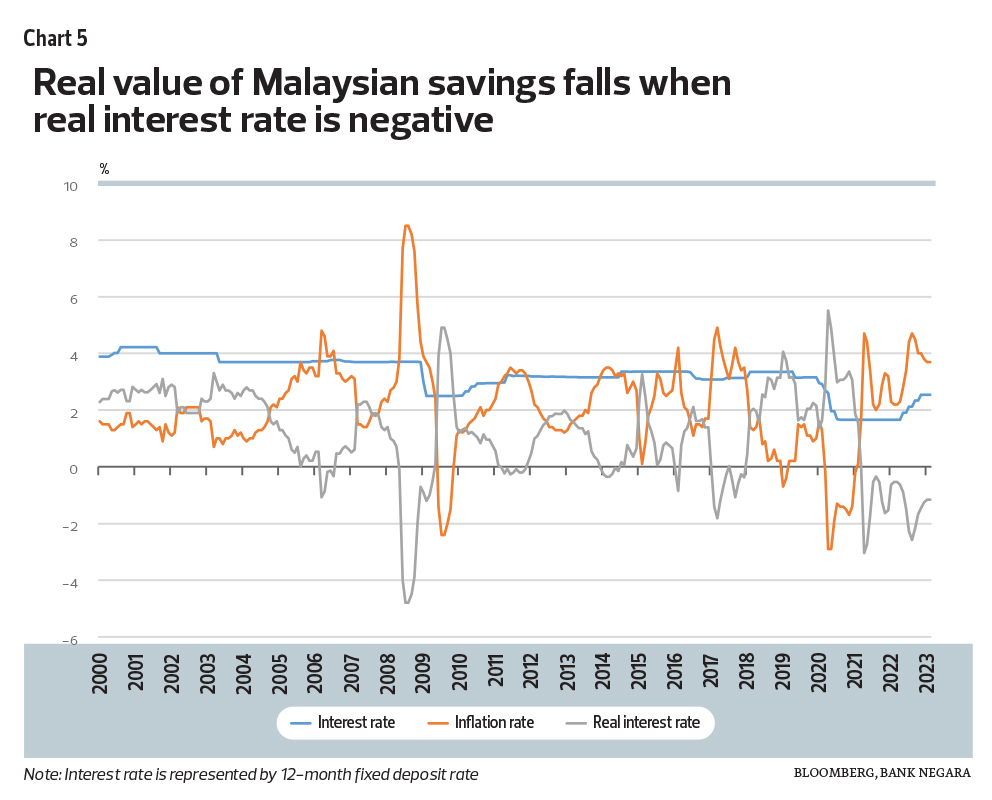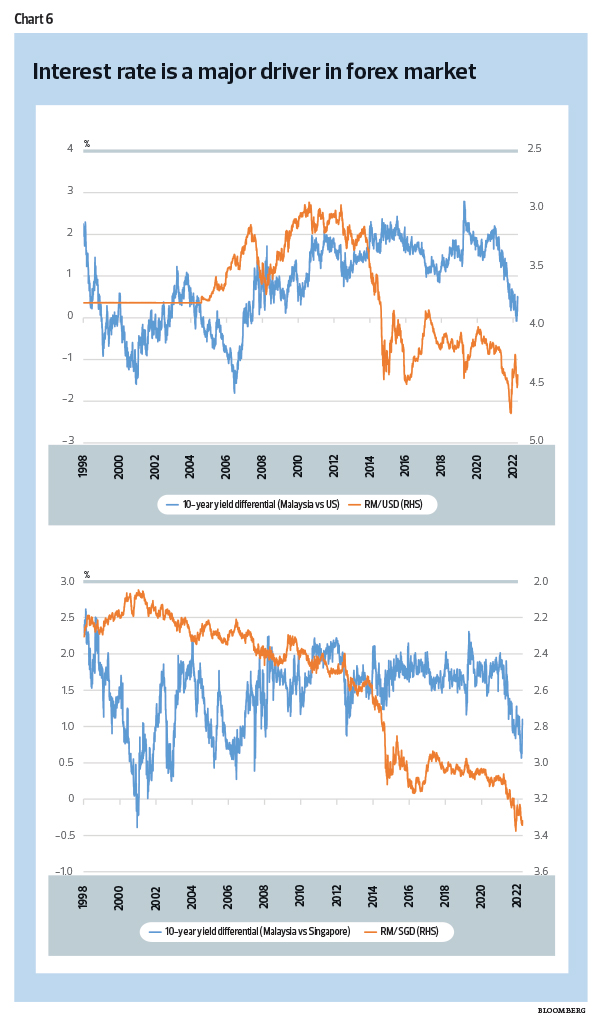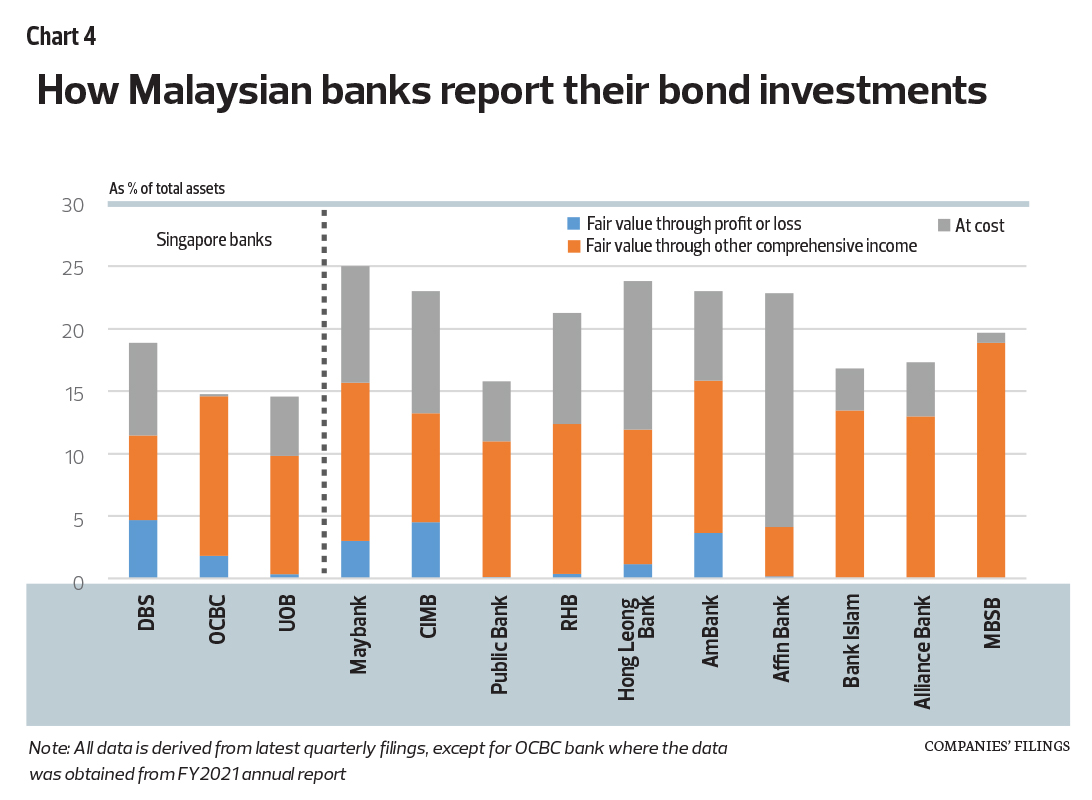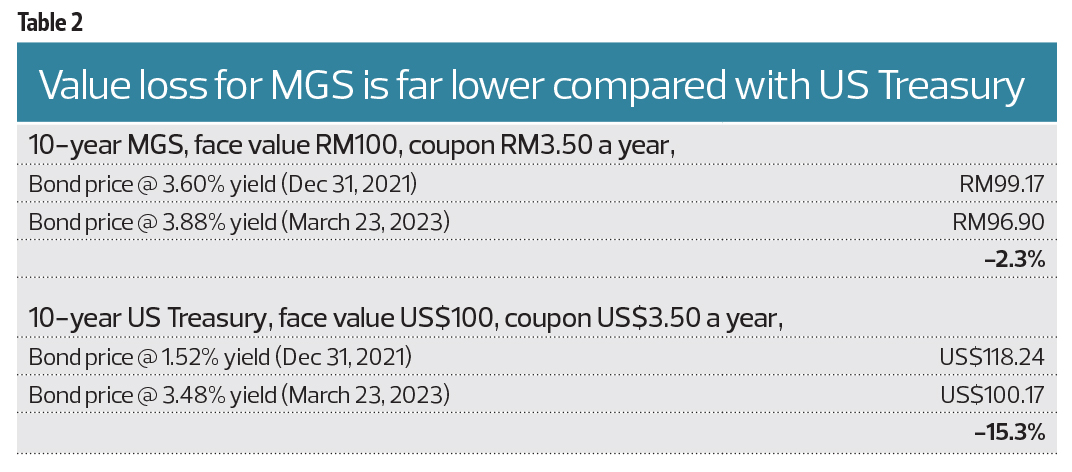Keep INVESTING Simple and Safe (KISS) ****Investment Philosophy, Strategy and various Valuation Methods**** The same forces that bring risk into investing in the stock market also make possible the large gains many investors enjoy. It’s true that the fluctuations in the market make for losses as well as gains but if you have a proven strategy and stick with it over the long term you will be a winner!****Warren Buffett: Rule No. 1 - Never lose money. Rule No. 2 - Never forget Rule No. 1.
Tuesday, 25 April 2023
Bond investing can sometimes fail
Saturday, 22 April 2023
Salutica share price had a big drop after having increased from RM 0.375 to a high of RM 1.72 over 13 days from 31/3/2023.
| Date | Adj Close Price | Volume |
|---|---|---|
| 3/1/2023 12:00:00 AM | 0.26 | 122,800 |
| 4/1/2023 12:00:00 AM | 0.255 | 112,200 |
| 5/1/2023 12:00:00 AM | 0.255 | 469,000 |
| 6/1/2023 12:00:00 AM | 0.25 | 129,700 |
| 9/1/2023 12:00:00 AM | 0.255 | 1,733,000 |
| 10/1/2023 12:00:00 AM | 0.255 | 62,000 |
| 11/1/2023 12:00:00 AM | 0.25 | 312,100 |
| 12/1/2023 12:00:00 AM | 0.255 | 666,500 |
| 13/1/2023 12:00:00 AM | 0.26 | 421,600 |
| 16/1/2023 12:00:00 AM | 0.26 | 221,200 |
| 17/1/2023 12:00:00 AM | 0.28 | 5,650,900 |
| 18/1/2023 12:00:00 AM | 0.275 | 596,300 |
| 19/1/2023 12:00:00 AM | 0.275 | 425,100 |
| 20/1/2023 12:00:00 AM | 0.27 | 507,100 |
| 25/1/2023 12:00:00 AM | 0.275 | 674,300 |
| 26/1/2023 12:00:00 AM | 0.295 | 4,067,600 |
| 27/1/2023 12:00:00 AM | 0.295 | 873,300 |
| 30/1/2023 12:00:00 AM | 0.285 | 1,744,400 |
| 31/1/2023 12:00:00 AM | 0.3 | 5,086,600 |
| 2/2/2023 12:00:00 AM | 0.33 | 6,305,400 |
| 3/2/2023 12:00:00 AM | 0.335 | 4,915,400 |
| 7/2/2023 12:00:00 AM | 0.315 | 1,166,300 |
| 8/2/2023 12:00:00 AM | 0.295 | 1,853,000 |
| 9/2/2023 12:00:00 AM | 0.3 | 739,200 |
| 10/2/2023 12:00:00 AM | 0.315 | 1,443,900 |
| 13/2/2023 12:00:00 AM | 0.305 | 960,400 |
| 14/2/2023 12:00:00 AM | 0.3 | 516,200 |
| 15/2/2023 12:00:00 AM | 0.285 | 1,524,500 |
| 16/2/2023 12:00:00 AM | 0.295 | 528,000 |
| 17/2/2023 12:00:00 AM | 0.295 | 112,800 |
| 20/2/2023 12:00:00 AM | 0.29 | 222,000 |
| 21/2/2023 12:00:00 AM | 0.28 | 883,700 |
| 22/2/2023 12:00:00 AM | 0.275 | 224,000 |
| 23/2/2023 12:00:00 AM | 0.28 | 83,500 |
| 24/2/2023 12:00:00 AM | 0.28 | 322,600 |
| 27/2/2023 12:00:00 AM | 0.245 | 7,673,800 |
| 28/2/2023 12:00:00 AM | 0.24 | 1,040,200 |
| 1/3/2023 12:00:00 AM | 0.24 | 560,400 |
| 2/3/2023 12:00:00 AM | 0.24 | 376,200 |
| 3/3/2023 12:00:00 AM | 0.24 | 1,895,200 |
| 6/3/2023 12:00:00 AM | 0.245 | 204,500 |
| 7/3/2023 12:00:00 AM | 0.25 | 259,700 |
| 8/3/2023 12:00:00 AM | 0.25 | 296,900 |
| 9/3/2023 12:00:00 AM | 0.255 | 171,400 |
| 10/3/2023 12:00:00 AM | 0.25 | 345,200 |
| 13/3/2023 12:00:00 AM | 0.245 | 348,100 |
| 14/3/2023 12:00:00 AM | 0.25 | 518,700 |
| 15/3/2023 12:00:00 AM | 0.25 | 85,500 |
| 16/3/2023 12:00:00 AM | 0.255 | 190,500 |
| 17/3/2023 12:00:00 AM | 0.265 | 195,200 |
| 20/3/2023 12:00:00 AM | 0.26 | 215,700 |
| 21/3/2023 12:00:00 AM | 0.26 | 219,000 |
| 22/3/2023 12:00:00 AM | 0.255 | 137,600 |
| 23/3/2023 12:00:00 AM | 0.255 | 69,900 |
| 24/3/2023 12:00:00 AM | 0.26 | 54,900 |
| 27/3/2023 12:00:00 AM | 0.245 | 86,400 |
| 28/3/2023 12:00:00 AM | 0.25 | 40,000 |
| 29/3/2023 12:00:00 AM | 0.29 | 2,923,500 |
| 30/3/2023 12:00:00 AM | 0.285 | 663,800 |
| 31/3/2023 12:00:00 AM | 0.375 | 33,136,100 |
| 3/4/2023 12:00:00 AM | 0.395 | 10,750,900 |
| 4/4/2023 12:00:00 AM | 0.495 | 37,114,600 |
| 5/4/2023 12:00:00 AM | 0.46 | 26,555,700 |
| 6/4/2023 12:00:00 AM | 0.555 | 25,778,300 |
| 7/4/2023 12:00:00 AM | 0.555 | 12,681,300 |
| 10/4/2023 12:00:00 AM | 0.68 | 50,511,800 |
| 11/4/2023 12:00:00 AM | 0.715 | 22,859,300 |
| 12/4/2023 12:00:00 AM | 0.765 | 37,209,300 |
| 13/4/2023 12:00:00 AM | 0.875 | 32,863,300 |
| 14/4/2023 12:00:00 AM | 1.09 | 56,461,800 |
| 17/4/2023 12:00:00 AM | 1.41 | 41,578,500# |
| 18/4/2023 12:00:00 AM | 1.65 | 60,618,300 |
| 19/4/2023 12:00:00 AM | 1.16 | 65,105,300 |
| 20/4/2023 12:00:00 AM | 0.815 | 100,220,300 |
2023-04-17
| 20/4/2023 Price per share RM 0.815 |
| Market Capital (RM) | EPS (cent) | ||||
| Number of Share | P/E Ratio |
Trade-off of limited interest rate hikes by Bank Negara
Bank Negara’s tempered OPR hikes limit interest rate risks for banking system …
… but there is a trade-off
- First, savers could have obtained more had interest rates gone higher. With high inflation, savings are now earning negative real rates (that is, below inflation) (see Chart 5).
- Second, the trade-off is a weaker ringgit — and higher cost of living for all Malaysians.
The interest rate is the price of money (or credit or time, if one is inclined to be argumentative) — and it certainly is one of the major drivers in foreign exchange movements (see Chart 6); although this relationship is by no means linear or perfect.
- Can a country maintain a relatively low interest rate while also stabilising its exchange rate?
- Is the weak ringgit a function of the interest rate differentials between the ringgit and other currencies or are there even more dominant factors?
Friday, 21 April 2023
How banks account for their bond holdings and treatments for unrealised gains and losses.
Banks have some discretion in terms of accounting for their bond holdings (which is part of financial assets and liabilities) and treatments for unrealised gains and losses.
- Under IFRS 9 (known as MFRS 9 in Malaysia and SFRS 109 in Singapore), bond investments can be measured at cost (if they are intended to be held to maturity) or at fair values (if they may be sold before maturity).
- And there are guidelines for treating changes in fair value measurements — they can be reflected through either the profit and loss (FVTPL) or other comprehensive income (FVOCI).
Under the first option, gains (losses) are recognised in the Income Statements, meaning reported net profit for the period is higher (lower).
Under the second option, gains (losses) are disclosed below the net profit line in the Statements of Comprehensive Income. In this case, the gains (losses) have no impact on reported net profit.
However, both the FVTPL and FVOCI options have balance sheet effects — unrealised gains (losses) will increase (decrease) retained earnings and shareholders’ equity (see Chart 4 for the different approaches in the accounting treatments for bond investments by Malaysian banks).
For instance, Affin Bank and, to a lesser extent, Hong Leong Bank have the highest proportions of bond investments measured at cost, which could indicate that, in the current environment, both their reported net profit and equity may be “overstated”. By comparison, the other seven local banks have, on average, mark-to-market some 63% of their bond holdings. In addition, Maybank, CIMB and Ambank would have adjusted their reported profit lower for a portion of these unrealised losses.
As mentioned above, bond holdings that are mark-to-market will affect balance sheets — unrealised losses or impairments will drag on the capital adequacy ratio of banks.
Herein lies the importance of Bank Negara’s more tempered path for interest rate hikes.
- The smaller interest rate hikes mean lower unrealised capital losses, thus limiting the negative impact on lending capacity and/or need to raise fresh capital.
- Smaller interest rate hikes also help keep a lid on the burden for debt servicing, for leveraged households, businesses as well as the government. Government debt and liabilities totalled RM1.5 trillion, or 83% of GDP.
Interest rate risks for the overall Malaysian banking system is low.
Is SVB a canary in the coal mine?
Clearly, the situation is quite different in Malaysia. For starters, pandemic cash handouts were far smaller and, while deposits also rose during the pandemic — owing to loan moratoriums and lower spending — it was nowhere near the scale of that in the US. Total deposits increased from RM1.968 trillion to RM2.186 trillion between March 2020 and March 2022, or equivalent to just about 11% growth (see Chart 2).
And while investments in government and corporate bonds also rose at the outset of the pandemic — as a result of excess deposits and lower loan demand — the increase was small, from 17.9% in January 2020 to a high of 19.7% of total assets in August 2021. Currently, the average bond holdings among Malaysian banks is 19.1% of total assets, or about RM645.2 billion, compared with 24% in the US banking system. Of note, 90% of the total are made up of local bonds — only 10% of which are foreign currency denominated bonds (see Chart 3).
Bank Negara’s tempered OPR hikes limit interest rate risks for banking system …
More importantly, Bank Negara Malaysia has raised the overnight policy rate (OPR) by only 1%, from 1.75% to 2.75% over the same period (compared with the 4.75% hike in the US FFR). Yields for the benchmark 10-year Malaysia Government Securities (MGS) have risen by even less — from 3.6% at the start of 2022 to 3.88% currently. The yield differential is less than 0.3%. This means the drop in value for 10-year MGS is only about 2.3%, based on our back-of-the-envelope calculations (see Table 2).
This is a huge difference compared to the 15.3% drop in value for the 10-year Treasury. Furthermore, unrealised losses for shorter duration bonds will be much lower. For instance, more than half of Maybank’s bond holdings have durations of less than five years.
In short, total unrealised losses for local banks should be much lower. (Incidentally, the majority of loans [79%] are based on floating interest rates, which are repriced immediately on Bank Negara’s policy rate changes.) Therefore, we think interest rate risks for the overall Malaysian banking system is low. Naturally, some banks will be affected more than others. For instance, Maybank, CIMB, Hong Leong Bank, Ambank, Affin Bank and RHB Bank have a higher percentage of bonds on their balance sheets compared with banks such as Public Bank, Bank Islam, Alliance Bank and MBSB. This could be due to a combination of factors, including deposit inflows, the ability to make loans and the target customer market.
The fallout of Silicon Valley Bank reverberated around the world
The fallout reverberated around the world — turning into a crisis of confidence in the global financial system.
In Europe, the Swiss government instructed UBS Group AG to mount an emergency rescue of compatriot Credit Suisse Group AG, which, incidentally, is already beset with its own set of problems.
Since the SVB turmoil, banks have lost tens of billions in market value, some more than others.
For instance, leading Japanese banks have been harder hit, as they had accumulated foreign bonds in recent years — in the search for yields on the back of more than two decades of a zero interest rate policy, crowding-out by the Bank of Japan as well as slow loans growth in the domestic market.
https://www.theedgemarkets.com/node/662043
Silicon Valley Bank became the second-largest bank to fail in US history
For a quick recap, Silicon Valley Bank (SVB) became the second-largest bank to fail in US history, the biggest being Washington Mutual Bank in 2008, following a run on the bank.
What happened?
SVB had an abnormally high percentage of bond holdings (56% of total assets) on its balance sheet and as unrealised losses mounted, worried depositors — mostly Silicon Valley start-ups and venture-capital firms with large, uninsured deposits (of more than US$250,000 per account) — rushed to withdraw their money.
The sudden huge outflow of deposits forced SVB to liquidate its bonds at current market values (losses), which then tipped it into insolvency (where the values of liabilities exceeded assets).
The bank had to be taken over by FDIC on March 10 to stem contagion fears.
Another regional bank, Signature Bank, suffered the same fate and went into FDIC receivership just days later.
Despite the quick actions, worries continued to spread to other smaller banks, all of which continue to suffer substantially higher-than-normal deposit withdrawals.
https://www.theedgemarkets.com/node/662043
The issues for SVB are, to a certain extent, idiosyncratic —
- an exceptionally narrow customer base and
- high uninsured deposits (according to various reports, they ranged from 88% to 96% of total deposits),
- abnormally high long-dated bond holdings relative to traditional loans and,
- critically, failure to hedge interest rate risks.
The overall US banking system is, no doubt, suffering from withdrawal symptoms — from excessive government stimulus, near-zero interest rates and massive quantitative easing over the past few years. At the outset of the pandemic, banks were inundated with large deposit inflows — excess savings surged from generous government handout, coupled with little avenue to spend during lockdowns.
Bank deposits increased by nearly US$5 trillion, or 35%, from about US$13.4 trillion in March 2020 to US$18.1 trillion in March 2022 (see Chart 1). Meanwhile, loans to businesses were limited during the pandemic. Banks had to put all these excess cash to work, and many ended up buying Treasuries and especially MBS (new mortgages and refinancing activities saw a huge jump as the housing sector boomed). Then the Fed started hiking interest rates aggressively.
Situation in Malaysia is quite different
Clearly, the situation is quite different in Malaysia.
For starters, pandemic cash handouts were far smaller and, while deposits also rose during the pandemic — owing to loan moratoriums and lower spending — it was nowhere near the scale of that in the US.
Total deposits increased from RM1.968 trillion to RM2.186 trillion between March 2020 and March 2022, or equivalent to just about 11% growth (see Chart 2).







